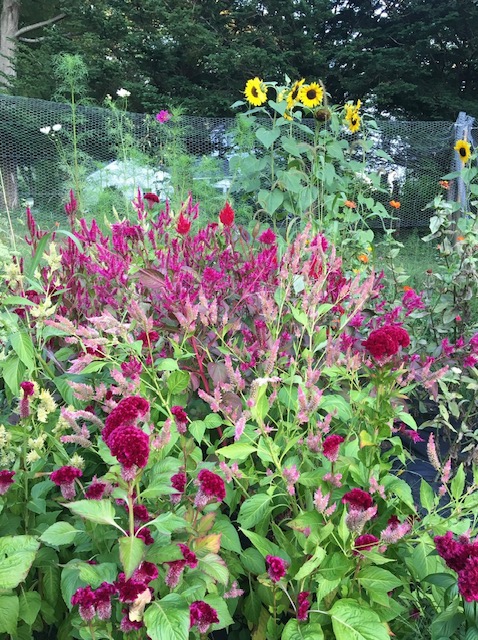Your Very Own Cutting Garden
When have you last bought flowering plants for the length of their stems? If you have used annuals to plant a cutting garden, then you’ve likely done this as recently as last summer, aiming to select the plants that will have the longest and sturdiest stems at maturity, able to dramatically display colorful blooms. These flowering plants are perfect for the at-home cutting garden.
Having a cutting garden may sound like a luxury, and it is. But it is not crazy-luxurious. Taking up just a bit of ground space, tall flowering plants can be selected for their ability to handle cutting without wilting, for their color, and for those stems just mentioned. Planted in a grouping that has enough good looks and variety to be ideal for “bouquet building”, these plants permit us as gardeners to decorate our homes all summer for a fraction of what we would spend at the florist or farmers’ market to purchase bouquets.
Who has enough money to have a bouquet on the dining table each night, nosegays in the bathrooms, small arrangements on nightstands in the bedrooms…? On a regular basis, treating oneself to all this might break the bank. Furthermore, most of us do not treat ourselves with such care. “Oh, I don’t need it. I’ll wait for a special occasion.” Such is the mantra of many a person… even some of the biggest flower lovers around.
But with a small patch of land devoted to tall flowering plants that have been added solely for the purpose of cutting and taking indoors, we do end up treating ourselves well. We do end up finding ourselves worthy of having bouquets here, there, and everywhere.
Yes, we can cut flowers from other parts of our property. They don’t necessarily need to come from something called a “cutting garden”. But making the cutting garden a fairly utilitarian space and naming it so very specifically means that gardeners can harvest without guilt. In other parts of the yard, we may lament the cuts we make on flowering plants; in the cutting garden, this harvesting is what is done… it fits the garden’s purpose.
I had heard a lot about cutting gardens from some homekeeping DIY gurus I’ve long admired. You probably know these pop culture icons too… they cook, garden, and tidy up so artfully that I hang on their every word on television and social media. And I have heard each talk of having a cutting garden. But the first time I saw a cutting garden in my own life, planted by a regular person in a regular yard… well, that’s when I knew this type of garden was not just for the well known, rich, or famous. This was within reach.
The cutting garden I saw was planted by my cousin, a cousin I often talk about when the topic is gardening. My cousin is a master gardener, skilled as can be, though she would never admit it. But the summer I saw the August results of her work, my jaw dropped. Gomphrena, tall Ageratum (at the time I knew of only the low-to-the-ground variety), Celosia, Cosmos, Zinnias, medium-sized Sunflowers.... She had it all. And the cutting and harvesting she had done all summer seemed to have resulted in increased flowering, just as relentless deadheading might: There was no end to the flowers she had.
My cousin explained that she had started almost everything from seed. Growth took place gradually. By my mid-August visit to her cutting garden, waiting time was only a memory, with lengthy stems on everything and color everywhere. But even my talented cousin recommended that small plant-starts be chosen over seeds when possible. With green starter plants to kick off the growing period, there would be more weeks of good cutting/harvesting, more bouquets, less waiting.

With just a simple mesh fencelike barrier to protect her flowering plants from some of the bigger creatures that might visit, my cousin’s cutting garden was full of plants that were packed tightly together. The flower-topped stems peeked out, giraffe-style, to find the sun; they had become just the right length for tall vases. Whether or not my cousin added small pathways in future years, I do not know; pathways would have made the task of accessing the plants and cutting them easier, but at the same time, it would have reduced planting space.
Knowing that it was within reach to create my own cutting garden, I took to heart these points: 1) Choose the right flowering plants, meaning ones with tall and sturdy stems and lots of color (think, Zinnias); 2) dedicate a single patch to everything that will go into a bouquet; 3) cordon off the area; 4) know that you will need to water your cutting garden regularly and well; 5) start with a small patch, meaning, remember that you don’t need to stock your local supermarket with flowers; and 6) make this the area where you don’t skimp on great soil, soil amendments, and fertilizer. (On the last point: You can go all-natural, such as with fish emulsion, but you must fertilize. Feed your flowering plants so that you can be satiated by their blooms.)
So, this year, like a talented home gardener I know who also happens to be a relative of mine, get some gorgeous Zinnias with their big puffs of color and sturdy stems; get indestructible Gomphrena plants which create beautiful dried bouquets; plant one of several varieties of Celosia for velvety additions to your bouquets; for delicate balloons of color on spires, try Snapdragons… then make the area where you planted these beauties strictly for cutting. Don’t add a water feature to your cutting garden. Don’t create a rock wall display. Make the area somewhat utilitarian—or at least as “utilitarian” as gorgeous, bright, satiny and velvety blooms planted en masse can be—and then when your flowering plants mature, cut, cut, cut. Treat yourself.
Comments
{{ errors.first("comment") }}